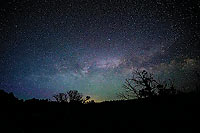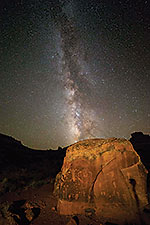From Delicate Arch to the Canyons of the Colorado and the imposing La Sal Mountains, the Moab area is filled with dramatic subjects for the photographer. Now, thanks to recent advances in camera technology, the lovely star fields of the Milky Way can be added to the list of subjects.
 We live in one of the best areas in the country for viewing the starry sky. In fact, according to Astronomy magazine, “The International Dark-Sky Association (IDA) has granted Gold-Tier International Dark-Sky Park status to Canyonlands National Park, an honor reserved for the darkest of dark skies and the most stunning of starscapes.” We live in one of the best areas in the country for viewing the starry sky. In fact, according to Astronomy magazine, “The International Dark-Sky Association (IDA) has granted Gold-Tier International Dark-Sky Park status to Canyonlands National Park, an honor reserved for the darkest of dark skies and the most stunning of starscapes.”
A clear night sky is essential to viewing the glowing band of light we call the Milky Way, which is in fact made up of the hundreds of millions of stars in our galaxy. The brightest part, looking toward the center of the galaxy, is located near the constellation Sagittarius, which appears low in the southern sky in summer. This means that photos can be composed in which the brightest part of the Milky Way is seen in conjunction with the landscape. More and more photographers are taking advantage of this to create night sky images of recognizable subjects such as Balanced Rock, Delicate Arch and many others.
The technology that makes this possible is the ability of modern camera sensors to work effectively at high sensitivity, or ISO. In the past, slower sensors required exposures so long that stars would become trails of light instead of the point-like images we see.
Another requirement is an ultra wide-angle lens capable of capturing those points of light without blurring, and even some pro-level lenses fail on this account due to an optical effect known as coma. If uncorrected, coma causes star images in the outer parts of a picture to show up as little teardrops instead of round points.
 Like many other photographers who have discovered the joy of Milky Way photography, I use a lens that is ideal for this purpose, the 14mm f/2.8 Rokinon. This is a completely manual lens that must be stopped down by hand. Made in Korea, the lenses are affordable and cover a full-frame 35mm camera sensor. Like many other photographers who have discovered the joy of Milky Way photography, I use a lens that is ideal for this purpose, the 14mm f/2.8 Rokinon. This is a completely manual lens that must be stopped down by hand. Made in Korea, the lenses are affordable and cover a full-frame 35mm camera sensor.
Armed with my new lens and Canon 6D full-frame 21-megapixel camera, I set out earlier this year to try my hand at capturing the galaxy. My first night was at Juniper campground along Sand Flats Road. As night came on I made this picture of the Milky Way with an exposure of 20 seconds at f/2.8, using a sturdy Gitzo tripod. The ISO was set at 3200. The glow of a distant camping tent shows up in the lower right corner.
 Turning my camera to the east, I photographed the portion of the Milky Way that contains the Summer Triangle constellations Lyra (the Harp), Cygnus (the Swan) and Aquila (the Eagle). I kept some foreground bushes in the picture to add interest, appearing as dark silhouettes. The bright star in the upper center is Vega, and the orange glow on the horizon is from distant lights of Castle Valley. Turning my camera to the east, I photographed the portion of the Milky Way that contains the Summer Triangle constellations Lyra (the Harp), Cygnus (the Swan) and Aquila (the Eagle). I kept some foreground bushes in the picture to add interest, appearing as dark silhouettes. The bright star in the upper center is Vega, and the orange glow on the horizon is from distant lights of Castle Valley.
Encouraged by these results I decided to add another factor to my night sky photography: “Light painting” foreground subjects. I obtained a high-intensity LED flashlight with a daylight-balanced bulb. My next shots were made near Fisher Towers, looking south across Fisher Mesa. I boosted the ISO on these and later shots to 6400, which gave me more exposure without having to use a longer exposure, which would have caused the star images to streak due to the rotation of the Earth. I used the flashlight to “paint” some of the foreground, with this result.
Next I decided to attempt to capture the spiritual essence of Birthing Rock, an Anasazi petroglyph site in Kane Creek Canyon. Using a remote release on my camera allowed me to stand back and to the side of the rock while painting it with the light for a brief time during the 20-second exposures. First I made a shot from further back, showing the rock in its setting.
Finally I moved in close to the petroglyph panel and raised my camera to the tripod’s highest setting at about seven feet. I placed the Milky Way so that it appears to flow into the rock, creating a mystical feeling about this ancient site. This is my favorite Milky Way image so far.
For more about photographing the Moab landscapes, see my website and blog at www.imagequest.photo.
David L. Brown is a writer and photographer who lives in Moab. A Life Member of the American Society of Media Photographers, he leads local photo tours and puts on photo and writing workshops. He is artist in residence at ACT Campground and Learning Center where a number of his photos are on display. |